Live reviews
 [by Ken Hunt, London] Brass Monkey was a band that unfurled before my eyes. Or so it seemed. From their varied beginnings consolidating in the trio of Martin Carthy, Howard Evans and John Kirkpatrick that performed from January to December 1980 to the establishment of the powerhouse acoustic quintet, Brass Monkey proper, in January 1981 of Carthy, Evans and Kirkpatrick with Martin Brinsford and Roger Williams, their impact was never less than revelatory.
[by Ken Hunt, London] Brass Monkey was a band that unfurled before my eyes. Or so it seemed. From their varied beginnings consolidating in the trio of Martin Carthy, Howard Evans and John Kirkpatrick that performed from January to December 1980 to the establishment of the powerhouse acoustic quintet, Brass Monkey proper, in January 1981 of Carthy, Evans and Kirkpatrick with Martin Brinsford and Roger Williams, their impact was never less than revelatory.
18. 5. 2009 |
read more...
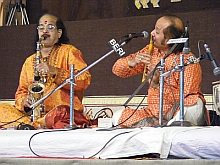 [by Ken Hunt, London] One of high-flyingest jugalbandis (duets) in Indian music it has ever been my utter pleasure to witness took place on 25 December 2008. It occurred on the opening day of the 133rd Harballabh Sangeet Sammelan in Jalandhar City in the northwest Indian state of Punjab. It was a North-South jugalbandi. The North was represented by the transverse bamboo flute or bansuri maestro Ronu Majumdar and the tabla virtuoso Ram Das Palsule. The South was represented by the alto saxophonist Kadri Gopalnath and Hari Kumar on the South’s double-headed barrel drum, mridangam.
[by Ken Hunt, London] One of high-flyingest jugalbandis (duets) in Indian music it has ever been my utter pleasure to witness took place on 25 December 2008. It occurred on the opening day of the 133rd Harballabh Sangeet Sammelan in Jalandhar City in the northwest Indian state of Punjab. It was a North-South jugalbandi. The North was represented by the transverse bamboo flute or bansuri maestro Ronu Majumdar and the tabla virtuoso Ram Das Palsule. The South was represented by the alto saxophonist Kadri Gopalnath and Hari Kumar on the South’s double-headed barrel drum, mridangam.
24. 2. 2009 |
read more...
[by Ken Hunt, London] Bang On A Can (BOAC) is an ensemble that blurs the boundaries between rock, the avant-garde and contemporary composition. Their concert in the Blauwe Zaal (‘Blue Room’) at DeSingel – a modernistic complex, founded, so to speak, on the deal that art is the basis and concrete of a culture – featured in its second half the headlining Czech vocalist-violinist Iva Bittová on her own or performing with BOAC. Note the hyphen because she does both at once and sometimes creates a third voice from the two elements in a manner that has to be seen in order to believe.
30. 1. 2009 |
read more...
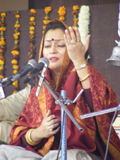 [by Ken Hunt, London] India has a long tradition of music festivals of the classical kind – often called music conferences – to compare with few places on the planet. Harballabh Sangeet Sammelan showed off everything that is typical and revealing about Indian audiences’ attitudes, including their waywardness, to its art music traditions. The December 2008 festival was its 133rd gathering in an unbroken sequence since 1875. The annual festival takes place in deepest winter. There were few concessions to comfort and that sense of musical austerity works brilliantly for a festival grounded in dhrupad – one of the more austere forms of Hindustani art music. People come wrapped in shawls, untold layers of clothing and carrying snacks. Tellingly, it is still a free festival.
[by Ken Hunt, London] India has a long tradition of music festivals of the classical kind – often called music conferences – to compare with few places on the planet. Harballabh Sangeet Sammelan showed off everything that is typical and revealing about Indian audiences’ attitudes, including their waywardness, to its art music traditions. The December 2008 festival was its 133rd gathering in an unbroken sequence since 1875. The annual festival takes place in deepest winter. There were few concessions to comfort and that sense of musical austerity works brilliantly for a festival grounded in dhrupad – one of the more austere forms of Hindustani art music. People come wrapped in shawls, untold layers of clothing and carrying snacks. Tellingly, it is still a free festival.
30. 1. 2009 |
read more...
H’ART Festival, Centre of Contemporary Art, Glasgow, Scotland, 8 November 2008
 [by Ken Hunt, London] Szilvia Bognár, Ágnes Herczku and Ági Szalóki’s album Szájról szájra – first released in Hungary in 2007 but invisible to the outside world until early in 2008 – ranks as one of the benchmark albums to emerge from the pan-European folk scene this decade. It is a master-class in the subtlety and power of interwoven voices as well as being a torrent of lessons on how to draw on traditional folk music and make it both now and timeless. But the wondrousness of Szájról szájra only really comes across in live performance when you match lips to sound.
[by Ken Hunt, London] Szilvia Bognár, Ágnes Herczku and Ági Szalóki’s album Szájról szájra – first released in Hungary in 2007 but invisible to the outside world until early in 2008 – ranks as one of the benchmark albums to emerge from the pan-European folk scene this decade. It is a master-class in the subtlety and power of interwoven voices as well as being a torrent of lessons on how to draw on traditional folk music and make it both now and timeless. But the wondrousness of Szájról szájra only really comes across in live performance when you match lips to sound.
13. 11. 2008 |
read more...
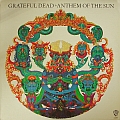 [by Ken Hunt, London] To declare an interest, Tom Constanten and I are addicts of bilingual punning and are old friends. Indeed we started our correspondence when I lived in Sutton, a town that I have no reason to return to in many years. As opener for Jefferson Starship, the audience got a magic show of multivalenced allusion, illusion and wordplay from the former keyboardist of the Grateful Dead during their wonderful experimental period as a septet in the late 1960s that produced Anthem of the Sun, Aoxomoxoa and Live Dead.
[by Ken Hunt, London] To declare an interest, Tom Constanten and I are addicts of bilingual punning and are old friends. Indeed we started our correspondence when I lived in Sutton, a town that I have no reason to return to in many years. As opener for Jefferson Starship, the audience got a magic show of multivalenced allusion, illusion and wordplay from the former keyboardist of the Grateful Dead during their wonderful experimental period as a septet in the late 1960s that produced Anthem of the Sun, Aoxomoxoa and Live Dead.
4. 11. 2008 |
read more...
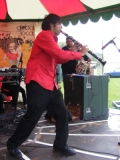 [by Ken Hunt, London] The sixth London Mela returned to its spiritual homeland on the borders of Hounslow and Ealing to the west of London once again and once again it was a celebration cum fair, which is all mela means in several of the subcontinent’s languages. The blurb on the front of the programme proclaimed: “Eight zones with urban, classical and experimental music, DJs, circus, dance, visual arts, comedy, children’s area, food from around the world and a giant funfair.”
[by Ken Hunt, London] The sixth London Mela returned to its spiritual homeland on the borders of Hounslow and Ealing to the west of London once again and once again it was a celebration cum fair, which is all mela means in several of the subcontinent’s languages. The blurb on the front of the programme proclaimed: “Eight zones with urban, classical and experimental music, DJs, circus, dance, visual arts, comedy, children’s area, food from around the world and a giant funfair.”
15. 8. 2008 |
read more...
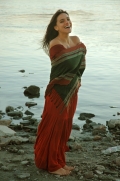 [by Ken Hunt, London] “There’s a lot of dancing in her music,” I say to the Hungarian dancer sitting next to me when the concert finishes. My observation about the performance has nothing to do with Beáta Palya as a dancer, little to do with her swaying or rockin’ in rhythm as she sings and everything to do with the way she sings. In a manner of speaking, Bea Palya sings from the haunches and the hips an awful lot. And what and how she sings is exceptional. The music she makes is Hungarian folk-crossed jazz or Hungarian jazz-crossed folk with other elements stirred in – chanson, for example, befitting her role in Tony Gatlif’s film Transylvania in which she plays the part of the cabaret chanteuse – that’s chantoozie in American-English.
[by Ken Hunt, London] “There’s a lot of dancing in her music,” I say to the Hungarian dancer sitting next to me when the concert finishes. My observation about the performance has nothing to do with Beáta Palya as a dancer, little to do with her swaying or rockin’ in rhythm as she sings and everything to do with the way she sings. In a manner of speaking, Bea Palya sings from the haunches and the hips an awful lot. And what and how she sings is exceptional. The music she makes is Hungarian folk-crossed jazz or Hungarian jazz-crossed folk with other elements stirred in – chanson, for example, befitting her role in Tony Gatlif’s film Transylvania in which she plays the part of the cabaret chanteuse – that’s chantoozie in American-English.
27. 7. 2008 |
read more...
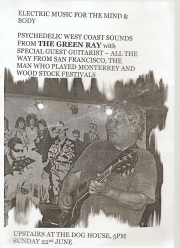 [by Ken Hunt, London] Don’t you just love the thrill of unpublicised gigs? So long, that is, that the act delivers music worthy of the buzz and you attend. This nicely semi-secret Green Ray gig ticked all the boxes and more. The Dog House announcement just promised “psychedelic West Coast sounds” and an unnamed “special guest guitarist – all the way from San Francisco, the man who played Monterrey and Wood Stock Festivals”. Yup, two spelling mistakes in 18 printed words. The Green Ray are still improvising and pursuing that ol’ psychedelic Grail. Were they an American band they’d probably get saddled with the description ‘jam band’.
[by Ken Hunt, London] Don’t you just love the thrill of unpublicised gigs? So long, that is, that the act delivers music worthy of the buzz and you attend. This nicely semi-secret Green Ray gig ticked all the boxes and more. The Dog House announcement just promised “psychedelic West Coast sounds” and an unnamed “special guest guitarist – all the way from San Francisco, the man who played Monterrey and Wood Stock Festivals”. Yup, two spelling mistakes in 18 printed words. The Green Ray are still improvising and pursuing that ol’ psychedelic Grail. Were they an American band they’d probably get saddled with the description ‘jam band’.
26. 6. 2008 |
read more...
[by Ken Hunt, London] The literature in the Barbican’s foyer called it “An evening of Ragas with legendary sitar player Ravi Shankar and his daughter Anoushka.” But it was far more than that. It also said, “Ravi Shankar – Farewell to Europe tour.” The sadness lay in the leave-taking. It meant that a good number of people attending in the audience were there to be able to say – at some stage later – that they had seen him in concert. It happens. It happened with Frank Sinatra and it happens with Bob Dylan and the Rolling Stones.
16. 6. 2008 |
read more...
« Later articles
Older articles »
 [by Ken Hunt, London] Brass Monkey was a band that unfurled before my eyes. Or so it seemed. From their varied beginnings consolidating in the trio of Martin Carthy, Howard Evans and John Kirkpatrick that performed from January to December 1980 to the establishment of the powerhouse acoustic quintet, Brass Monkey proper, in January 1981 of Carthy, Evans and Kirkpatrick with Martin Brinsford and Roger Williams, their impact was never less than revelatory.
[by Ken Hunt, London] Brass Monkey was a band that unfurled before my eyes. Or so it seemed. From their varied beginnings consolidating in the trio of Martin Carthy, Howard Evans and John Kirkpatrick that performed from January to December 1980 to the establishment of the powerhouse acoustic quintet, Brass Monkey proper, in January 1981 of Carthy, Evans and Kirkpatrick with Martin Brinsford and Roger Williams, their impact was never less than revelatory. [by Ken Hunt, London] One of high-flyingest jugalbandis (duets) in Indian music it has ever been my utter pleasure to witness took place on 25 December 2008. It occurred on the opening day of the 133rd Harballabh Sangeet Sammelan in Jalandhar City in the northwest Indian state of Punjab. It was a North-South jugalbandi. The North was represented by the transverse bamboo flute or bansuri maestro Ronu Majumdar and the tabla virtuoso Ram Das Palsule. The South was represented by the alto saxophonist Kadri Gopalnath and Hari Kumar on the South’s double-headed barrel drum, mridangam.
[by Ken Hunt, London] One of high-flyingest jugalbandis (duets) in Indian music it has ever been my utter pleasure to witness took place on 25 December 2008. It occurred on the opening day of the 133rd Harballabh Sangeet Sammelan in Jalandhar City in the northwest Indian state of Punjab. It was a North-South jugalbandi. The North was represented by the transverse bamboo flute or bansuri maestro Ronu Majumdar and the tabla virtuoso Ram Das Palsule. The South was represented by the alto saxophonist Kadri Gopalnath and Hari Kumar on the South’s double-headed barrel drum, mridangam.  [by Ken Hunt, London] India has a long tradition of music festivals of the classical kind – often called music conferences – to compare with few places on the planet. Harballabh Sangeet Sammelan showed off everything that is typical and revealing about Indian audiences’ attitudes, including their waywardness, to its art music traditions. The December 2008 festival was its 133rd gathering in an unbroken sequence since 1875. The annual festival takes place in deepest winter. There were few concessions to comfort and that sense of musical austerity works brilliantly for a festival grounded in dhrupad – one of the more austere forms of Hindustani art music. People come wrapped in shawls, untold layers of clothing and carrying snacks. Tellingly, it is still a free festival.
[by Ken Hunt, London] India has a long tradition of music festivals of the classical kind – often called music conferences – to compare with few places on the planet. Harballabh Sangeet Sammelan showed off everything that is typical and revealing about Indian audiences’ attitudes, including their waywardness, to its art music traditions. The December 2008 festival was its 133rd gathering in an unbroken sequence since 1875. The annual festival takes place in deepest winter. There were few concessions to comfort and that sense of musical austerity works brilliantly for a festival grounded in dhrupad – one of the more austere forms of Hindustani art music. People come wrapped in shawls, untold layers of clothing and carrying snacks. Tellingly, it is still a free festival. [by Ken Hunt, London] Szilvia Bognár, Ágnes Herczku and Ági Szalóki’s album Szájról szájra – first released in Hungary in 2007 but invisible to the outside world until early in 2008 – ranks as one of the benchmark albums to emerge from the pan-European folk scene this decade. It is a master-class in the subtlety and power of interwoven voices as well as being a torrent of lessons on how to draw on traditional folk music and make it both now and timeless. But the wondrousness of Szájról szájra only really comes across in live performance when you match lips to sound.
[by Ken Hunt, London] Szilvia Bognár, Ágnes Herczku and Ági Szalóki’s album Szájról szájra – first released in Hungary in 2007 but invisible to the outside world until early in 2008 – ranks as one of the benchmark albums to emerge from the pan-European folk scene this decade. It is a master-class in the subtlety and power of interwoven voices as well as being a torrent of lessons on how to draw on traditional folk music and make it both now and timeless. But the wondrousness of Szájról szájra only really comes across in live performance when you match lips to sound.  [by Ken Hunt, London] To declare an interest, Tom Constanten and I are addicts of bilingual punning and are old friends. Indeed we started our correspondence when I lived in Sutton, a town that I have no reason to return to in many years. As opener for Jefferson Starship, the audience got a magic show of multivalenced allusion, illusion and wordplay from the former keyboardist of the Grateful Dead during their wonderful experimental period as a septet in the late 1960s that produced Anthem of the Sun, Aoxomoxoa and Live Dead.
[by Ken Hunt, London] To declare an interest, Tom Constanten and I are addicts of bilingual punning and are old friends. Indeed we started our correspondence when I lived in Sutton, a town that I have no reason to return to in many years. As opener for Jefferson Starship, the audience got a magic show of multivalenced allusion, illusion and wordplay from the former keyboardist of the Grateful Dead during their wonderful experimental period as a septet in the late 1960s that produced Anthem of the Sun, Aoxomoxoa and Live Dead. [by Ken Hunt, London] The sixth London Mela returned to its spiritual homeland on the borders of Hounslow and Ealing to the west of London once again and once again it was a celebration cum fair, which is all mela means in several of the subcontinent’s languages. The blurb on the front of the programme proclaimed: “Eight zones with urban, classical and experimental music, DJs, circus, dance, visual arts, comedy, children’s area, food from around the world and a giant funfair.”
[by Ken Hunt, London] The sixth London Mela returned to its spiritual homeland on the borders of Hounslow and Ealing to the west of London once again and once again it was a celebration cum fair, which is all mela means in several of the subcontinent’s languages. The blurb on the front of the programme proclaimed: “Eight zones with urban, classical and experimental music, DJs, circus, dance, visual arts, comedy, children’s area, food from around the world and a giant funfair.” [by Ken Hunt, London] “There’s a lot of dancing in her music,” I say to the Hungarian dancer sitting next to me when the concert finishes. My observation about the performance has nothing to do with Beáta Palya as a dancer, little to do with her swaying or rockin’ in rhythm as she sings and everything to do with the way she sings. In a manner of speaking, Bea Palya sings from the haunches and the hips an awful lot. And what and how she sings is exceptional. The music she makes is Hungarian folk-crossed jazz or Hungarian jazz-crossed folk with other elements stirred in – chanson, for example, befitting her role in Tony Gatlif’s film Transylvania in which she plays the part of the cabaret chanteuse – that’s chantoozie in American-English.
[by Ken Hunt, London] “There’s a lot of dancing in her music,” I say to the Hungarian dancer sitting next to me when the concert finishes. My observation about the performance has nothing to do with Beáta Palya as a dancer, little to do with her swaying or rockin’ in rhythm as she sings and everything to do with the way she sings. In a manner of speaking, Bea Palya sings from the haunches and the hips an awful lot. And what and how she sings is exceptional. The music she makes is Hungarian folk-crossed jazz or Hungarian jazz-crossed folk with other elements stirred in – chanson, for example, befitting her role in Tony Gatlif’s film Transylvania in which she plays the part of the cabaret chanteuse – that’s chantoozie in American-English. [by Ken Hunt, London] Don’t you just love the thrill of unpublicised gigs? So long, that is, that the act delivers music worthy of the buzz and you attend. This nicely semi-secret Green Ray gig ticked all the boxes and more. The Dog House announcement just promised “psychedelic West Coast sounds” and an unnamed “special guest guitarist – all the way from San Francisco, the man who played Monterrey and Wood Stock Festivals”. Yup, two spelling mistakes in 18 printed words. The Green Ray are still improvising and pursuing that ol’ psychedelic Grail. Were they an American band they’d probably get saddled with the description ‘jam band’.
[by Ken Hunt, London] Don’t you just love the thrill of unpublicised gigs? So long, that is, that the act delivers music worthy of the buzz and you attend. This nicely semi-secret Green Ray gig ticked all the boxes and more. The Dog House announcement just promised “psychedelic West Coast sounds” and an unnamed “special guest guitarist – all the way from San Francisco, the man who played Monterrey and Wood Stock Festivals”. Yup, two spelling mistakes in 18 printed words. The Green Ray are still improvising and pursuing that ol’ psychedelic Grail. Were they an American band they’d probably get saddled with the description ‘jam band’.